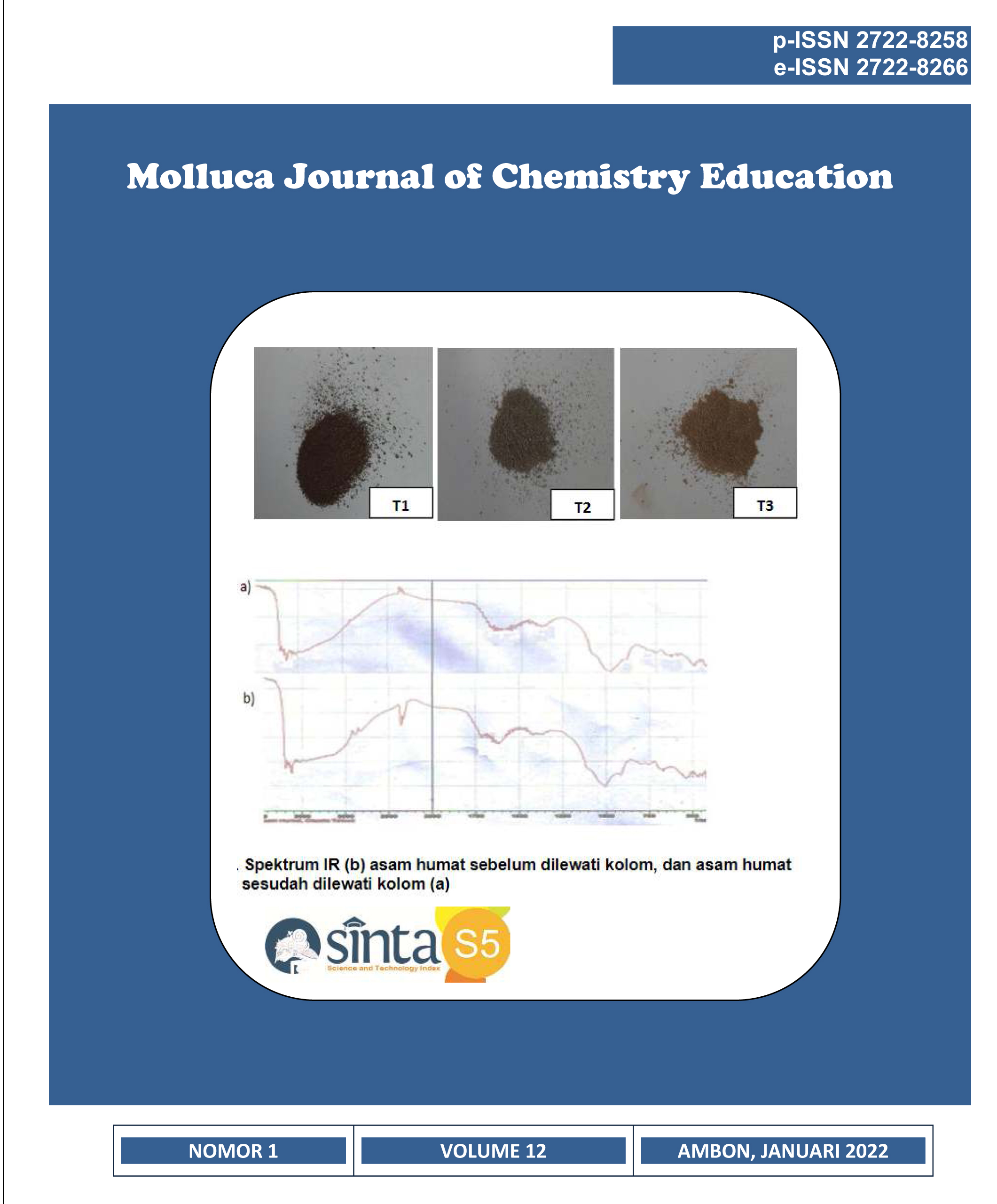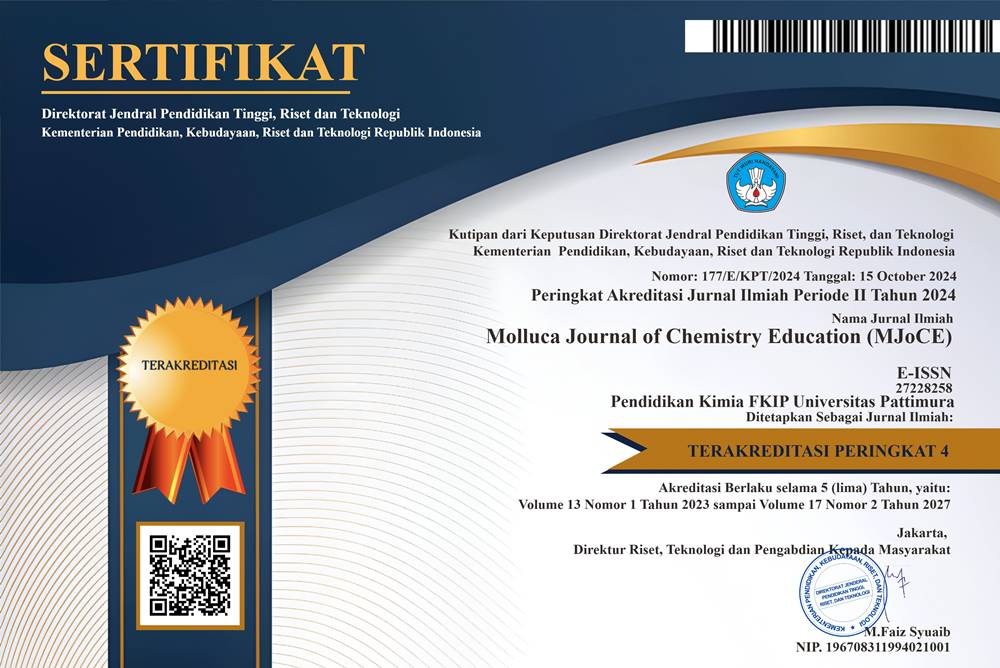SINTESIS DAN KARAKTERISASI ZEOLIT MORDENIT (MOR) SECARA HIDROTERMAL MENGGUNAKAN KAOLIN DAN ABU SEKAM PADI SEBAGAI SUMBER SILIKA
Abstract
Sintesis dan karakterisasi mordenit telah dilakukan dari abu sekam padi dan kaolin sumber silika dan alumina. Mordenit berhasil disintesis dari kaolin dan abu sekam padi menggunakan metode hidrotermal. Penelitian ini bertujuan untuk mengkaji proses pembentukan mordenit yang disintesis dari bahan alam. Komposisi rasio molar 10 Na2O : 100 SiO2 : 2 Al2O3 : 1800 H2O. Sintesis dilakukan secara hidrotermal pada suhu 175 °C selama 24 jam. Kaolin dan abu sekam padi langsung digunakan tanpa perlakuan lebih lanjut. Mordenit yang diperoleh dikarakterisasi dengan metode difraksi sinar-X (XRD).
Downloads
References
[2] M. Yoldi, E. G. Fuentes-Ordoñez, S. A. Korili, and A. Gil, “Zeolite synthesis from industrial wastes,” Microporous Mesoporous Mater., vol. 287, pp. 183–191, 2019, doi: https://doi.org/10.1016/j.micromeso.2019.06.009.
[3] Treacy, Michael M J and J. B. Higgins, Collection of Simulated XRD Powder Patterns for Zeolites Fifth (5th) Revised Edition. Elsevier, 2007.
[4] S. Banerjee, S. Barman, and G. Halder, “Sorptive elucidation of rice husk ash derived synthetic zeolite towards deionization of coalmine waste water: A comparative study,” Groundw. Sustain. Dev., vol. 5, pp. 137–151, 2017, doi: https://doi.org/10.1016/j.gsd.2017.06.004.
[5] J.-J. F. Saceda, R. L. de Leon, K. Rintramee, S. Prayoonpokarach, and J. Wittayakun, “Properties of silica from rice husk and rice husk ash and their utilization for zeolite y synthesis,” Quim. Nova, vol. 34, no. 8, pp. 1394–1397, 2011, doi: 10.1590/S0100-40422011000800018.
[6] Y. Shen, P. Zhao, and Q. Shao, “Porous silica and carbon derived materials from rice husk pyrolysis char,” Microporous Mesoporous Mater., vol. 188, pp. 46–76, 2014, doi: https://doi.org/10.1016/j.micromeso.2014.01.005.
[7] M. Foroughi, A. Salem, and S. Salem, “Characterization of phase transformation from low grade kaolin to zeolite LTA in fusion technique: Focus on quartz melting and crystallization in presence of NaAlO2,” Mater. Chem. Phys., vol. 258, p. 123892, 2021, doi: https://doi.org/10.1016/j.matchemphys.2020.123892.
[8] S. K. Kirdeciler and B. Akata, “One pot fusion route for the synthesis of zeolite 4A using kaolin,” Adv. Powder Technol., vol. 31, no. 10, pp. 4336–4343, 2020, doi: https://doi.org/10.1016/j.apt.2020.09.012.
[9] C. Covarrubias, R. García, R. Arriagada, J. Yánez, and M. T. Garland, “Cr(III) exchange on zeolites obtained from kaolin and natural mordenite,” Microporous Mesoporous Mater., vol. 88, no. 1, pp. 220–231, 2006, doi: https://doi.org/10.1016/j.micromeso.2005.09.007.
[10] Y. Wang, H. Jia, P. Chen, X. Fang, and T. Du, “Synthesis of La and Ce modified X zeolite from rice husk ash for carbon dioxide capture,” J. Mater. Res. Technol., vol. 9, no. 3, pp. 4368–4378, 2020, doi: https://doi.org/10.1016/j.jmrt.2020.02.061.
[11] E. B. G. Johnson and S. E. Arshad, “Hydrothermally synthesized zeolites based on kaolinite: A review,” Appl. Clay Sci., vol. 97–98, pp. 215–221, 2014, doi: https://doi.org/10.1016/j.clay.2014.06.005.
[12] “Structural Chemistry of Microporous Materials,” Chemistry of Zeolites and Related Porous Materials. pp. 19–116, 18-Jul-2007, doi: https://doi.org/10.1002/9780470822371.ch2.
[13] C. S. Cundy and P. A. Cox, “The hydrothermal synthesis of zeolites: Precursors, intermediates and reaction mechanism,” Microporous Mesoporous Mater., vol. 82, no. 1, pp. 1–78, 2005, doi: https://doi.org/10.1016/j.micromeso.2005.02.016.
[14] R. M. Mohamed, I. A. Mkhalid, and M. A. Barakat, “Rice husk ash as a renewable source for the production of zeolite NaY and its characterization,” Arab. J. Chem., vol. 8, no. 1, pp. 48–53, 2015, doi: https://doi.org/10.1016/j.arabjc.2012.12.013.
[15] E.-P. Ng, H. Awala, K.-H. Tan, F. Adam, R. Retoux, and S. Mintova, “EMT-type zeolite nanocrystals synthesized from rice husk,” Microporous Mesoporous Mater., vol. 204, pp. 204–209, 2015, doi: https://doi.org/10.1016/j.micromeso.2014.11.017.
[16] P. Cubillas and M. W. Anderson, “Synthesis Mechanism: Crystal Growth and Nucleation,” Zeolites and Catalysis. pp. 1–55, 21-Apr-2010, doi: https://doi.org/10.1002/9783527630295.ch1.
[17] D. Wu, B. Zhang, L. Yan, H. Kong, and X. Wang, “Effect of some additives on synthesis of zeolite from coal fly ash,” Int. J. Miner. Process., vol. 80, no. 2, pp. 266–272, 2006, doi: https://doi.org/10.1016/j.minpro.2006.05.005.
[18] J. de C. Izidoro, D. A. Fungaro, J. E. Abbott, and S. Wang, “Synthesis of zeolites X and A from fly ashes for cadmium and zinc removal from aqueous solutions in single and binary ion systems,” Fuel, vol. 103, pp. 827–834, 2013, doi: https://doi.org/10.1016/j.fuel.2012.07.060.
[19] X. Zhang, D. Tang, and G. Jiang, “Synthesis of zeolite NaA at room temperature: The effect of synthesis parameters on crystal size and its size distribution,” Adv. Powder Technol., vol. 24, no. 3, pp. 689–696, 2013, doi: https://doi.org/10.1016/j.apt.2012.12.010.
[20] B. J. Schoeman, J. Sterte, and J.-E. Otterstedt, “Colloidal zeolite suspensions,” Zeolites, vol. 14, no. 2, pp. 110–116, 1994, doi: https://doi.org/10.1016/0144-2449(94)90004-3.
[21] H. Liu, S. Peng, L. Shu, T. Chen, T. Bao, and R. L. Frost, “Magnetic zeolite NaA: Synthesis, characterization based on metakaolin and its application for the removal of Cu2+, Pb2+,” Chemosphere, vol. 91, no. 11, pp. 1539–1546, 2013, doi: https://doi.org/10.1016/j.chemosphere.2012.12.038.
[22] M. A. Klunk et al., “Synthesis and characterization of mordenite zeolite from metakaolin and rice husk ash as a source of aluminium and silicon,” Chem. Pap., vol. 74, no. 8, pp. 2481–2489, 2020, doi: 10.1007/s11696-020-01095-4.
Copyright (c) 2022 Molluca Journal of Chemistry Education (MJoCE)

This work is licensed under a Creative Commons Attribution-NonCommercial-ShareAlike 4.0 International License.





